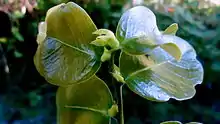| Zollernia | |
|---|---|
 | |
| Zollernia latifolia | |
| Scientific classification | |
| Kingdom: | Plantae |
| Clade: | Tracheophytes |
| Clade: | Angiosperms |
| Clade: | Eudicots |
| Clade: | Rosids |
| Order: | Fabales |
| Family: | Fabaceae |
| Subfamily: | Faboideae |
| Tribe: | Exostyleae |
| Genus: | Zollernia Wied-Neuw. & Nees (1827) |
| Species[1][2] | |
| |
| Synonyms[3] | |
| |
Zollernia is a genus of flowering plants in the legume family, Fabaceae. It includes 10 species native to South America, ranging from Venezuela and the Guianas to southern Brazil.[3] Zollernia are trees or shrubs that flower annually. Species are most commonly found in dense moist forests, but also grow in seasonally-dry cerrado (savanna and open woodland) and caatinga (deciduous thorn woodland and scrub).[3]
Leaves of Zollernia ilicifolia are used medicinally as an analgesic and antiulcerogenic by the peoples of the Brazilian tropical Atlantic Rainforest.
References
- ↑ "ILDIS LegumeWeb entry for Zollernia". International Legume Database & Information Service. Cardiff School of Computer Science & Informatics. Retrieved 1 February 2014.
- ↑ USDA; ARS; National Genetic Resources Program. "GRIN species records of Zollernia". Germplasm Resources Information Network—(GRIN) [Online Database]. National Germplasm Resources Laboratory, Beltsville, Maryland. Retrieved 1 February 2014.
- 1 2 3 Zollernia Wied-Neuw. & Nees. Plants of the World Online. Retrieved 23 September 2023.
This article is issued from Wikipedia. The text is licensed under Creative Commons - Attribution - Sharealike. Additional terms may apply for the media files.